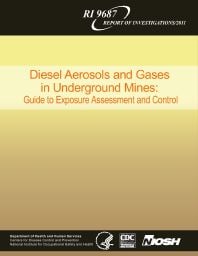Mining Product: Diesel Aerosols and Gases in Underground Mines: Guide to Exposure Assessment and Control
Original creation date: October 2011
Authors: AD Bugarski, SJ Janisko, EG Cauda, JD Noll, SE Mischler
Pittsburgh, PA: U.S. Department of Health and Human Services, Public Health Service, Centers for Disease Control and Prevention, National Institute for Occupational Safety and Health, DHHS (NIOSH) Publication No. 2012-101 (RI 9687), October 2011 ; :1-159
Diesel engines are a major contributor to concentrations of submicron aerosols, CO, CO2, NOX, SO2 and hydrocarbons (HC) in underground coal and metal/nonmetal mines. The extensive use of diesel-powered equipment in underground mines makes it challenging to control workers’ exposure to submicron aerosols and noxious gases emitted by those engines. In order to protect workers, mines need to establish a comprehensive program based on a multifaceted and integrated approach. Many of the technologies and strategies available to the coal and metal/nonmetal underground mining industries to control exposures of underground miners to diesel pollutants are similar. The effort to reduce the exposure of underground miners to diesel pollutants requires the involvement of several key departments of mining companies, including those responsible for health and safety, engine/vehicle/exhaust aftertreatment maintenance, mine ventilation, and production, as well as the departments responsible for acquiring vehicles, engines, exhaust aftertreatment systems, fuel, and lubricating oil.

Pittsburgh, PA: U.S. Department of Health and Human Services, Public Health Service, Centers for Disease Control and Prevention, National Institute for Occupational Safety and Health, DHHS (NIOSH) Publication No. 2012-101 (RI 9687), October 2011 ; :1-159